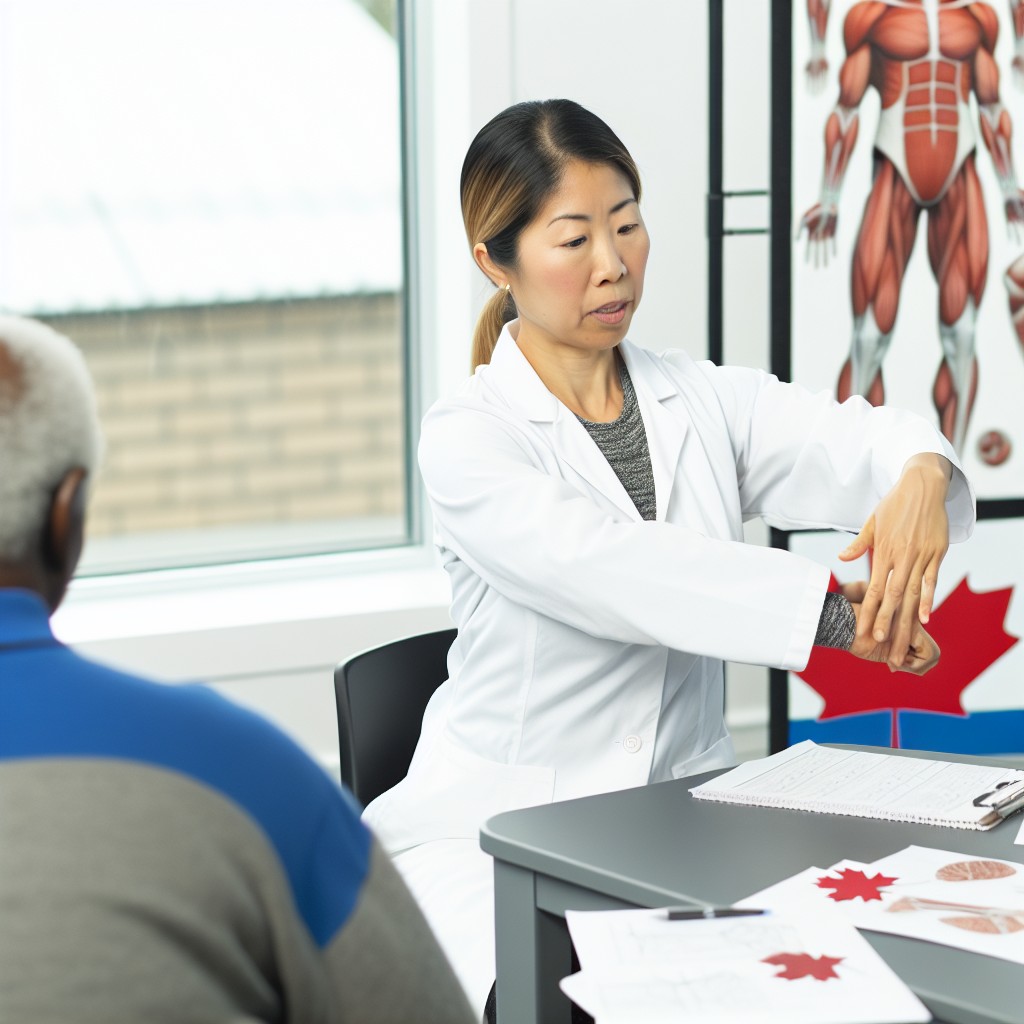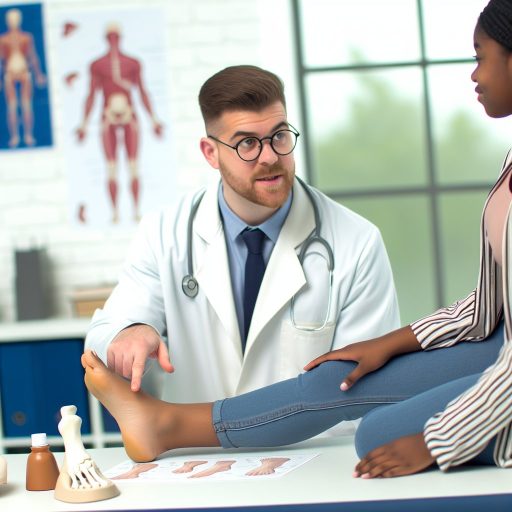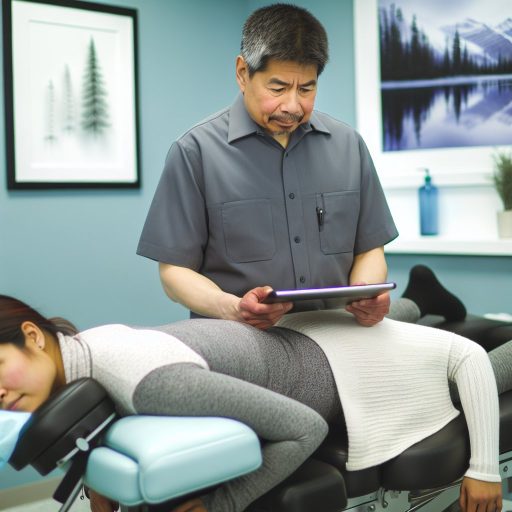Introduction to Kinesiology
Definition of Kinesiology
Kinesiology is the scientific study of human movement.
It examines the mechanics of motion and the physiological effects on the body.
This field merges anatomy, biomechanics, and psychology.
Kinesiology aims to improve physical performance and overall health.
Importance of Kinesiology
Kinesiology is vital for physical rehabilitation.
It helps individuals recover from injuries and regain mobility.
Additionally, it enhances athletic performance through proper training techniques.
Understanding kinesiology promotes injury prevention strategies.
Moreover, it encourages healthy lifestyle choices for everyone.
Applications in Daily Life
Kinesiologists work in various settings, including clinics and gyms.
They create tailored exercise programs for clients.
Furthermore, they assess body mechanics to improve functionality.
This discipline contributes to workplace ergonomics and safety.
Hence, kinesiology plays a crucial role in public health initiatives.
The Role of Anatomy in Human Movement
Understanding the Basics of Anatomy
Anatomy provides the foundational knowledge for understanding human movement.
It examines the structures of the body, including muscles, bones, and joints.
Each component plays a unique role in enabling movement.
For instance, bones provide support and structure.
Muscles generate the force required for movement.
Joints act as the points of connection between bones.
The Interaction of Muscles and Joints
Muscles and joints work together to facilitate motion.
When a muscle contracts, it pulls on the bone to create movement.
This interaction defines how we perform various activities.
For example, the biceps muscle aids in elbow flexion.
Such coordinated movements depend on proper muscle function.
Unlock Your Career Potential
Visualize a clear path to success with our tailored Career Consulting service. Personalized insights in just 1-3 days.
Get StartedAny imbalance can hinder efficiency and lead to injuries.
The Importance of Muscle Groups
Understanding muscle groups enhances knowledge of human movement.
Muscle groups work synergistically during physical activities.
For example, the quadriceps and hamstrings stabilize the knee joint.
Furthermore, the core muscles stabilize the spine during various movements.
This coordination plays a crucial role in athletic performance.
Additionally, it helps prevent injuries in everyday tasks.
Analyzing Movement Patterns
Movement patterns reveal critical insights into anatomy and function.
Through analysis, professionals can identify correct and incorrect techniques.
For instance, studying a runner’s gait can uncover biomechanical weaknesses.
This information aids in developing targeted training programs.
Ultimately, understanding movement patterns improves overall performance and safety.
The Role of Flexibility and Strength
Flexibility and strength are vital in human movement dynamics.
Flexibility enhances the range of motion at joints.
It allows for smoother and more efficient movements.
On the other hand, strength provides the necessary power for actions.
A well-rounded approach ensures optimal performance in physical activities.
Incorporating both elements leads to a lower risk of injury.
Biomechanics: Analyzing Movement Patterns
Understanding Biomechanics
Biomechanics combines principles of physics and biology.
This field studies the mechanics of human movement.
It applies to both athletic performance and rehabilitation.
Professionals analyze how forces interact with the body.
They map movement patterns through careful observation.
Movement Analysis Techniques
Various techniques exist to analyze human movement.
Motion capture systems provide detailed data.
These systems record body movements in three dimensions.
Additionally, force plates measure the impact of movements.
Gait analysis assesses walking and running patterns.
The Role of Muscles and Joints
Muscles and joints play critical roles in movement.
They work together to produce motion efficiently.
Muscles generate force, while joints facilitate movement.
This interplay helps maintain balance and posture.
Applications of Biomechanics
Biomechanics has various practical applications.
- In sports, it enhances performance and reduces injury.
- In rehabilitation, it aids recovery from injuries.
- In ergonomics, it improves workplace design.
Engineers utilize biomechanics in product development.
They create equipment that supports natural movement.
Future Directions in Biomechanics
The field of biomechanics continues to evolve.
Advancements in technology enhance data collection methods.
Researchers explore new materials for improved performance.
Future studies will deepen our understanding of human movement.
This knowledge could lead to innovative healthcare solutions.
Explore Further: Understanding The Role Of An Audiologist In Canada
Physiology of Exercise: How the Body Responds to Movement
Initial Response to Exercise
The body initiates a series of responses upon starting exercise.
First, heart rate increases to supply muscles with more oxygen.
Next, breathing rate elevates, enhancing oxygen intake.
This process happens within seconds of beginning physical activity.
Muscle Activation
Muscle fibers respond to signals from the nervous system.
Type I fibers support endurance activities through aerobic processes.
Conversely, Type II fibers aid in high-intensity efforts.
These fibers engage based on the activity’s demands.
Energy Production
The body converts nutrients into usable energy during exercise.
Carbohydrates serve as the primary source of fuel.
Fat reserves also contribute during prolonged, low-intensity activities.
Moreover, the breakdown of these nutrients releases ATP.
Body Temperature Regulation
Exercise generates internal heat, challenging the body’s thermal balance.
The body responds by activating sweat glands.
This process facilitates cooling through evaporation.
Maintaining a stable temperature is crucial for optimal performance.
Endocrine Response
Exercise influences hormonal secretion throughout the body.
Adrenaline and noradrenaline levels rise during intense activity.
These hormones enhance energy availability and readiness.
Additionally, endorphins release, which improves mood and reduces pain.
Long-Term Adaptations
Regular exercise leads to significant physiological adaptations.
Muscle strength and endurance improve over time.
The cardiovascular system becomes more efficient, benefiting overall health.
Furthermore, these adaptations contribute to enhanced sports performance.
Learn More: Role of Kinesiologists in Enhancing Physical Well-Being
Neuromuscular Control: Understanding Motor Skills and Coordination
The Role of the Nervous System
The nervous system is crucial for motor skill development.
It receives signals from the body and sends them to the brain.
This process helps coordinate movement effectively.
Furthermore, the central nervous system regulates muscle activity.
This regulation is essential for maintaining balance and posture.
Motor Control and Learning
Motor control refers to the mechanisms that facilitate movement.
Learning new motor skills occurs through practice and feedback.
Repetition enhances neural plasticity in the brain.
This plasticity allows for improved coordination over time.
Consistent practice also helps create muscle memory.
Types of Motor Skills
Motor skills are broadly categorized into two types.
These types are gross motor skills and fine motor skills.
Gross motor skills involve large muscle groups.
Examples include walking, running, and jumping.
In contrast, fine motor skills require precise movement.
Writing and buttoning a shirt are common examples.
Factors Influencing Motor Skills
Several factors influence the development of motor skills.
- Age is a significant factor affecting motor skills.
- Physical fitness also plays a crucial role.
- Cognitive development impacts coordination and planning.
- Environmental factors, such as space and equipment, matter as well.
Moreover, individual differences in motivation influence skill acquisition.
Neuromuscular Disorders
Neuromuscular disorders can significantly impact motor control.
These disorders affect the communication between nerves and muscles.
Conditions such as multiple sclerosis and muscular dystrophy are examples.
These conditions can lead to weakness, reduced coordination, and pain.
Enhancing Motor Skills
Training programs can enhance neuromuscular control.
Strength training improves muscular strength and endurance.
Balance training focuses on maintaining stability during movement.
Finally, flexibility training increases the range of motion.
All these components contribute to better overall performance.
Learn More: Skills Needed To Become A Speech-Language Pathologist
Psychological Aspects of Movement: Motivation and Performance
The Role of Motivation in Movement
Motivation drives individuals to engage in physical activities.
It influences the intensity and duration of exercise sessions.
Furthermore, motivation can be intrinsic or extrinsic.
Intrinsic motivation comes from within, such as personal satisfaction.
Extrinsic motivation stems from external rewards, like trophies or accolades.
Types of Motivation
Understanding different types of motivation is vital.
Mastery motivation focuses on skill enhancement.
Performance motivation emphasizes achieving goals and recognition.
Social motivation comes from a desire to connect with others.
Each type impacts individuals differently in their movement pursuits.
Factors Influencing Motivation
Several factors can heighten or diminish motivation.
Goals play a crucial role in motivating physical activity.
Setting achievable goals fosters a sense of accomplishment.
Environment also influences motivation levels.
Supportive social circles boost motivation for exercise.
The Impact of Psychological States on Performance
Psychological states significantly affect physical performance.
Anxiety can hinder movement efficiency and coordination.
Conversely, positive emotions enhance performance outcomes.
Confidence is paramount for peak performance in sports.
Preparation and visualization help build confidence levels.
Strategies to Enhance Motivation and Performance
Adopting specific strategies can improve motivation and performance.
Positive self-talk is essential for reinforcing confidence.
Visualization techniques aid in mentally preparing for performance.
Engaging in goal-setting promotes commitment to exercise routines.
Lastly, tracking progress can motivate continued effort.
Discover More: Challenges Speech-Language Pathologists Often Face

Kinesiology in Rehabilitation: Techniques and Approaches
Understanding Kinesiology in Rehabilitation
Kinesiology plays a vital role in rehabilitation practices.
It focuses on human movement and the science behind it.
This discipline assists in assessing and enhancing physical function.
Practitioners utilize various techniques to aid recovery.
Assessment Techniques
Qualified professionals often start with comprehensive assessments.
These assessments identify movement limitations and pain points.
Functional tests evaluate the body’s strength and flexibility.
Additionally, they analyze posture and gait patterns.
Functional Movement Screening
Functional movement screening evaluates fundamental movements.
This process helps detect potential risk factors for injury.
By identifying these risks, practitioners develop targeted interventions.
Range of Motion Evaluations
Range of motion evaluations determine the flexibility of joints.
These evaluations help in creating personalized exercise plans.
Improving flexibility can significantly enhance rehabilitation outcomes.
Rehabilitation Techniques
Practitioners employ various rehabilitation techniques for recovery.
Manual therapy is a common approach used to alleviate pain.
It often involves joint mobilization and soft tissue manipulation.
Physical therapy exercises help strengthen target muscle groups.
Therapeutic Exercises
Therapeutic exercises play a crucial role in rehabilitation.
They often focus on specific muscles or movements needed for daily activities.
This helps improve strength, endurance, and flexibility.
Neuromuscular Re-education
Neuromuscular re-education also aids patients in regaining coordination.
This technique improves the brain’s ability to communicate with the muscles.
Ultimately, it enhances overall movement patterns.
The Role of Technology
Advancements in technology have transformed rehabilitation practices.
Wearable devices track movement and performance metrics.
This data helps practitioners adjust rehabilitation plans accordingly.
Furthermore, virtual reality offers innovative ways to practice movement.
Telehealth Services
The rise of telehealth services broadens access to rehabilitation.
Patients can receive guidance from home using video consultations.
This flexibility improves adherence to rehabilitation protocols.
Collaborative Approaches
Collaboration among healthcare professionals enhances recovery outcomes.
Interdisciplinary teams often include physiotherapists and occupational therapists.
This teamwork provides a comprehensive care strategy for patients.
Such approaches ensure that all aspects of rehabilitation are covered.
Applications of Kinesiology in Sports Performance Enhancement
Understanding Kinesiology’s Role
Kinesiology plays a crucial role in enhancing sports performance.
It combines principles from biomechanics, anatomy, and physiology.
This multidimensional approach improves athletes’ training outcomes.
Assessing Movement Patterns
Accurately assessing movement patterns is essential for performance improvement.
Kinesiologists analyze athletes’ biomechanics during activities.
This analysis identifies strengths and weaknesses in movement.
Subsequently, tailored training programs address specific needs.
Injury Prevention Strategies
Injury prevention is a key focus of kinesiology.
Kinesiologists develop strategies to reduce injury risks.
They utilize knowledge of biomechanics and tissue properties.
Educational workshops often enhance athletes’ understanding.
Consequently, athletes adopt safer techniques during training.
Optimizing Training Techniques
Kinesiology helps optimize training techniques for better results.
It encourages the use of proper techniques and body mechanics.
Regular evaluations ensure that athletes remain on the right track.
Moreover, feedback from kinesiologists boosts motivation levels.
Incorporating Technology in Training
Technology enhances kinesiology practices in sports settings.
Wearable devices track movement and vital statistics.
This data allows for immediate performance assessments.
Athletes and coaches can make informed decisions quickly.
Evaluating Mental Factors
Mental aspects significantly contribute to sports performance.
Kinesiology research includes psychological factors affecting athletes.
Training programs often integrate mental conditioning techniques.
As a result, athletes develop greater focus and resilience.
Real-World Applications in Various Sports
Kinesiology principles apply across many sports disciplines.
In basketball, kinesiologists enhance shooting techniques.
In soccer, they optimize sprinting and agility movements.
This diverse application ensures athletes reach their fullest potential.
Collaboration with Coaches and Trainers
Collaboration among kinesiologists and coaching staff leads to success.
Regular communication ensures everyone is aligned on goals.
Coaches implement kinesiologists’ recommendations in practice sessions.
This teamwork maximizes training effectiveness and athlete progress.
The Future of Kinesiology: Technological Innovations and Research Trends
Emerging Technologies in Kinesiology
Technological advancements continuously reshape the field of kinesiology.
Wearable devices offer real-time movement tracking and data collection.
These devices enhance athlete performance evaluation and physical rehabilitation.
Moreover, virtual and augmented reality create immersive training environments.
This technology simulates real-world scenarios to improve motor skills.
Impact of Artificial Intelligence
Artificial intelligence (AI) transforms data analysis in kinesiology.
AI algorithms can identify movement patterns and predict injuries.
This technology aids in personalized training programs for individuals.
Ultimately, it enhances overall athletic performance and safety.
Current Research Trends
Research in kinesiology increasingly emphasizes biomechanics and neuromuscular function.
These studies improve our understanding of human movement.
Current trends focus on how different sports impact physical health.
Furthermore, researchers explore the psychological aspects of movement.
This exploration examines motivation and mental health benefits.
Future Directions in Kinesiology Education
Educational institutions adapt to these technological changes.
Curricula now incorporate advanced technologies and methodologies.
Students gain hands-on experience with cutting-edge tools.
This prepares them for diverse careers in health and fitness industries.
The Role of Interdisciplinary Collaboration
Collaboration between disciplines enhances kinesiology research.
Partnerships with engineering and computer science yield innovative solutions.
These collaborations lead to improved rehabilitation protocols and training methods.
Also, they foster a better understanding of complex human movement issues.
Additional Resources
School of Health and Exercise Sciences: UBC’s Okanagan Campus
MS in Human Movement & Rehabilitation Sciences – Northeastern …




